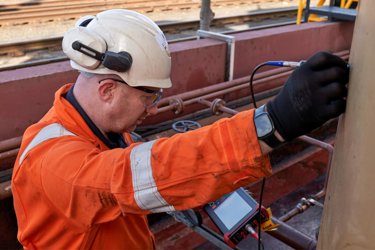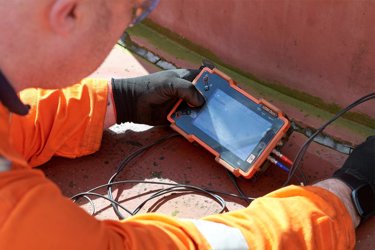Carrying out internal inspection and non-destructive testing (NDT) of fuel tanks at three depots
Published: 30 May 2023
Project overview
It is important to inspect your tanks for signs of degradation to prevent escape of product which could cause a pollution incident. If you have an escape of product, being able to provide documented evidence of inspections and maintenance will help to reduce the impact of regulatory enforcement. Because of this, Northern Trains asked us to perform non-destructive testing (NDT) on its fuel tanks at three of its depots.
According to EEMUA 159, fuel tanks should be externally checked with NDT every 5 years, and internally every 10 years. This is a 10-yearly inspection.

Our solution
To allow us to perform the internal inspection we first need to uplift the fuel and clean the tank.
We then look to detect and assess potential problems like corrosion, stress, cracking and pitting in fuel tanks and pipework. Carrying out non-destructive testing on your storage tanks over time can provide trend-based information on deterioration, helping to predict where issues might be found and successfully prevent a pollution incident.
All inspection data will be provided to the client in the form of a report with our recommendations and advice on any remediation or maintenance requirements.
Outcome and results
Maintenance of your storage tanks, bunds and separators is vitally important to reduce the risk to the environment, your operation, and your reputation. We advise a program of inspection and maintenance based on your specific risk profile.
Where we uplifted the fuel, we took the opportunity to clean the tank and also polish the fuel to ensure the client’s fuel quality is maintained. We find that planned preventive maintenance schedules can lower reactive maintenance costs in the long term and extend the lifespan of your asset.
What are the standards around non-destructive testing?
EEMUA 159 and API 653 are the two standards for NDT that may be used by a regulator to determine if the organisation is adopting best available maintenance techniques.
API recommends all tanks shall be given a visual external inspection by an authorised inspector at least every 5 years and internal inspection no longer than every 20 years.
EEMUA proposes external inspections anywhere from 1-year to 15-years, and internal inspections from 3-years to 20-years depending on the climate and product stored.

Different types of NDT
- Visual testing: Finding defects that are visible to the naked eye
- Ultrasonic testing (UT): Uses sound waves to test thickness of structure
- Magnetic flux leakage (MFL): Uses magnetic field and sensors to identify leakage
- Liquid penetrant testing (LPT): A liquid and then a developer is applied to the surface to highlight any surface-level defects
- Magnetic particle testing (MT): Similar magnetic process to MFL, used on ferromagnetic materials
- Electromagnetic testing (ET): Sometimes called eddy current testing. Uses an energised coil to create a magnetic field highlighting any faults
More from our Knowledge Hub
Environmental compliance today, creating a sustainable tomorrow
Helping you reduce risk to the environment and your operation by managing assets compliantly while achieving commercial, ESG, and net-zero goals.
Contact our experts




